
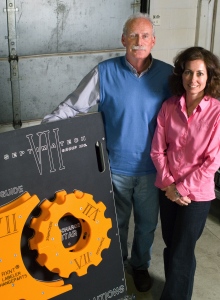
Photo by Cole Garside
One of the very few upsides of an economic recession is that it inevitably separates industry leaders and shining lights from pretenders and also-rans lacking the competitive skillset and inner strength to cope with the tough going.
Which bodes very well in terms of future prospects for the likes of Septimatech Group Inc., Waterloo, Ont.-based industrial systems designer and manufacturer that was actually hiring new staff throughout last year—just as most of Canada’s manufacturing base was shedding jobs at
rates not seen since the Great Depression.
According to company president and chief executive officer Sharron Gilbert, the company—founded in 1993 by her father Peter Fenton and six other enterprising packaging professionals with varied backgrounds in design engineering, sales and marketing, manufacturing and quality assurance, administration and service—managed to hold its own during the recession in large part by reaffirming its commitment to the company’s seven core founding principles.
“All of our employees follow a seven-part ‘Leadership Legacy’ that was formulated by my father: be committed to the customer; deliver superior quality; act with trust and honesty; do business with class and dignity; cooperate and share responsibility; communicate openly with others; and
take leadership and share the excitement of being part of Septimatech,” says Gilbert.
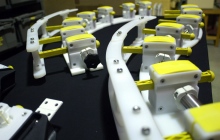
Photo by Cole Garside
“It’s a big part of our cultural identity,” Gilbert told Canadian Packaging on a recent visit to the company’s modern, 16,000-square-foot manufacturing facility that now employs 52 people to manufacture change-parts, components, tooling and subsystems for custom container handling applications in the food-and-beverage, pharmaceutical, personal-care and home-care products, OEM (original equipment manufacturer) and other industrial sectors.
MIND THE GAP
“It was nice to have that 20-cent differential between our Canadian and U.S. dollar before, but when that differential began to shrink, we put together a strategy that would help us make a profit even if it were to hit par,” relates Gilbert, saying the company achieved this goal with a keen focus on cutting internal costs within its process management and production workflow, as well as making better use of its workforce.
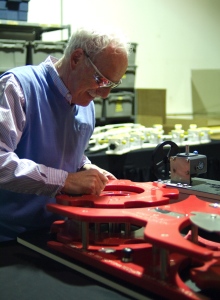
Photo by Cole Garside
“Septimatech took a hard look at itself and realized that if it was to not only survive but succeed in this economic climate, we were going to have to make a few changes in how we did business.
“We would never lose sight of our seven core business values,” she says, “but we knew we needed to trim the waste in how we operated.”
While becoming a leaner enterprise became a top priority, Gilbert points out that the company never wavered from its firm commitment to R&D (research-and-development), which she credits to helping it become a leader in the manufacture of quick-change tooling, change-parts, feedscrews, label handling components, parts storage solutions, feedscrew drive systems, and guide-rail adjustment devices.
“We’re always looking for ways to stay ahead of the curve with regards to product and container motion control, so that all of our computer-engineered designs and manufacturing procedures can help the customer succeed,” explains Gilbert. “Because when they succeed, we succeed.
“And since we’re in the business of helping our customers achieve their production goals more efficiently, we needed to do the same within our operations.”
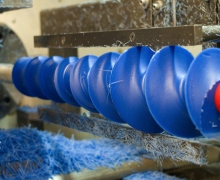
Photos by Cole Garside
Vice-president of sales and marketing Jim O’Keeffe credits the company’s seven co-founders—who used the Latin word septima (seven) to come up with the name Septimatech—for maintaining its customer-centric corporate culture even after the passing of Peter Fenton.
“Our core business is to provide easy-to-implement solutions for production lines that will increase machine performance and optimize line efficiency,” states O’Keeffe.
“We do this by providing our niche market clients with three key items: What they want; how they want it; and when they want it.”
Gilbert and O’Keeffe both agree that their Septimatech is especially well-positioned to cope with the recessionary pressures because many of its customers simply don’t have the budgets for high-ticket capital investment projects—making them more likely to spend what they have on enhancing the performance of their existing machinery with the sort of products manufactured by Septimatech.
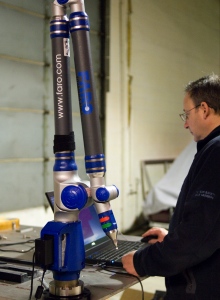
Photo by Cole Garside
“Nowadays companies aren’t looking to reinvest large amounts of money with capital investments into brand new equipment,” says Gilbert. “But because companies still want and need to improve how they operate, they can spend far less on upgrading their equipment and achieve virtually the same results with the products that we offer.”
One such noteworthy product is the comprehensive line of RXNT (Rapid eXchange No Tools) change-parts—designed specifically to enable manufa
cturers to speed up their once-tedious changeovers in a cost-effective manner, with minimal machine downtime.
“We follow the 5-S principles of lean manufacturing in the way we design our systems: sort, simplify, shine, standardize and sustain,” O’Keeffe explains. “So we simplified our change-parts to make sure that no tools are required to perform the changeover; most parts weigh less than nine kilograms (20 pounds); and we use our ‘puzzle-cut’ manufacturing technique to make sure that the parts can only fit together in one particular way—making it virtually impossible to put the parts on incorrectly.
“The RXNT change-parts system we created increases productivity and profitability by reducing changeover production downtime and increasing throughput by providing complete container control through all the steps of the process,” says O’Keeffe, adding that Septimatech can manufacture its parts from many different materials to suit the customers’ application requirements—including the lightweight, highly durable UHMW (ultra high molecular weight) polyethylene that can be color-coded with 81 different combinations for simple product identification.
GUIDING LIGHT
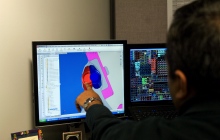
Photo by Cole Garside
Another popular Septimatech product offering is the recently-launched Unison Modular Flex Guide System—an innovative guide rail adjustment solution designed to let conveyor system users change up to 24.4 meters (80 feet) of guide-rail along any conveyor shape, including straight, S-bends, crossovers and corners, from a single position.
“Depending on one’s needs, the customer could purchase an off-the-shelf format or a custom-designed Unison system,” says O’Keeffe. “In fact, by purchasing off-the-shelf, the customers need only to order the exact pieces they need for their specific applications.
“The nice thing is that should the customer later discover a need to expand or alter their current conveyance system, the Unison solution is modular, which makes it easy to change and install.”
Because most of the work done by Septimatech involves the retrofitting of parts and systems on over 225 different types of machines, the company’s in-house design team makes extensive use of 3D (three-dimensional) simulation software systems to ensure the manufacture of precisely-machined, perfectly-sized parts and components.
“There’s no point in us looking at a starwheel on a bottling line and merely adding a component unless we are sure it will not adversely affect the rest of the production down the line,” states O’Keeffe. “Septimatech is all about doing its due diligence.”
Adds Gilbert: “For us, it’s all about solving the customer’s problem. Because of Septimatech’s size, we have a relatively short decision tree, which means our response time is quicker.
“And for us, having a fast turnaround time, smart and courteous staff, and being able to offer an affordable alternative to purchasing new equipment are all key parts of what has helped Septimatech grow its business, unlike many of our competitors.”
Advertisement

